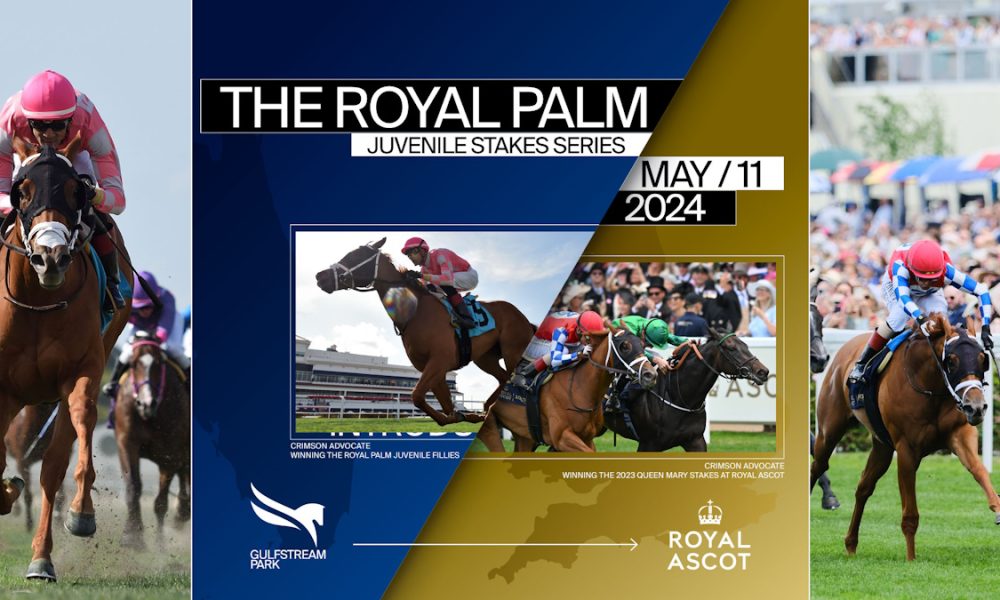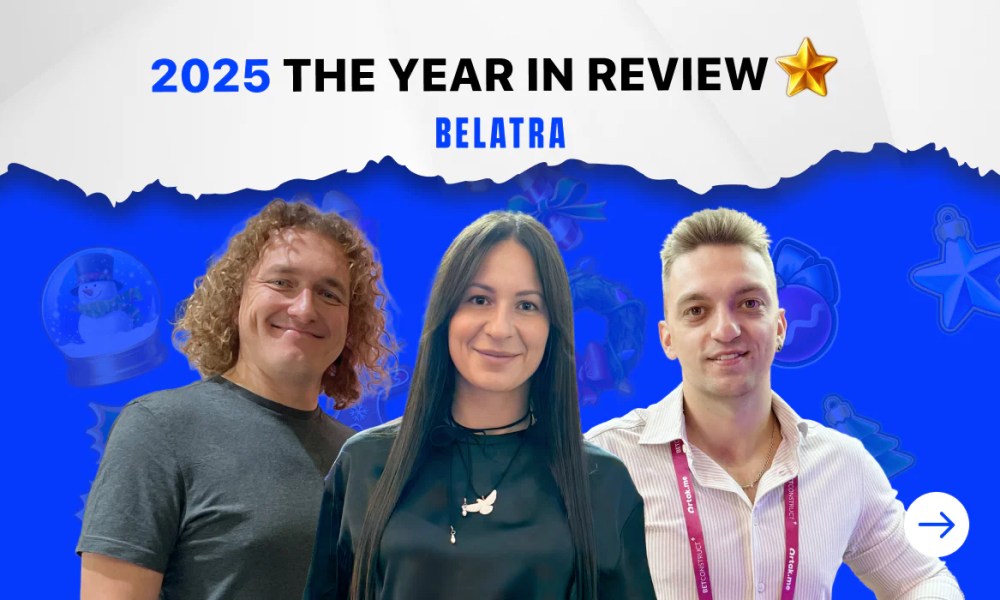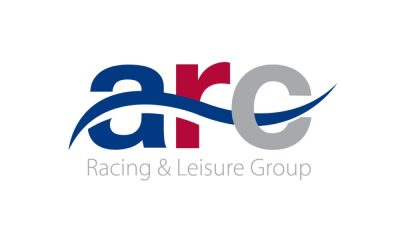Latest News
Impressive fields assembled for Royal Ascot automatic qualifiers at Gulfstream Park

Automatic spots and a trip to Royal Ascot are on the line this Saturday at Gulfstream Park, with a pair of two-year-old turf stakes (the Royal Palm Juvenile and Royal Palm Juvenile Fillies) bearing important international implications. These five-furlong sprints each carry $120,000 purses and boast capacity fields of 12.
The Royal Palm series, launched last May, produced immediate returns in its inaugural year, with Crimson Advocate winning the Juvenile Fillies at Gulfstream Park before going on to land the prestigious Group 2 Queen Mary Stakes. Once again, this innovative series’ winners will receive an automatic berth into one of six two-year-old events at Royal Ascot, alongside a free equine travel stipend for shipping from the US.
Innovative partnerships like the Royal Palm are helping to improve North American participation and boost international interest at the world’s biggest meetings. 1/ST are putting their shoulders to the wheel for other ground-breaking initiatives in the immediate future, including recent partnerships with The Jockey Club (for the Group 1 Coral-Eclipse and the My Pension Expert July Cup) and France Galop (for the Group 1 Sumbe Prix Jean Romanet Stakes).
Meet the contenders for the Royal Palm Juvenile Fillies (Race 8):
#1-CHINA BLUE: Outrun fifth of 6 at Gulfstream May 2 and would be wheeling back on 9 days’ rest for trainer Javier Gonzalez. Last year’s runners in this race who had a Gulfstream prior outing finished fourth, eighth and ninth.
#2-KIP THE DISTANCE: Close-up second in debut dirt sprint at Gulfstream 9 days ago when finishing 6 lengths in front of returning rival China Blue. Sent off at nearly 22-1 at first asking for trainer Angel Rodriguez. Last year’s runners in this race who had a Gulfstream prior outing finished fourth, eighth and ninth.
#3-BUNRATTY MANOR: Trainer George Weaver (pictured above) swept last year’s Royal Palm Juvenile Fillies and Juvenile in the inaugural year for the event. Son of No Nay Never, who sired last year’s Royal Palm Juvenile winner No Nay Mets. Pair of turf works at Palm Beach Downs among the morning prep work for Saturday’s first outing. Sold for $195,000 at Goff’s yearling sale.
#4-YOU NEED ME: Rookie colt is by Triple Crown winner American Pharoah’s less-accomplished full-brother St. Patrick’s Day. Sold for $50,000 at Ocala in March and debuts off a series of dirt works for trainer J. David Braddy.
#5-BULLET: Trainer Mark Casse was third in this race last year with The Myth. Brings this $425,000 Keeneland September Yearling Sale buy to her debut off a long series of works at Casse farm and Palm Meadows. War Front colt is a maternal grandson of Surfside and great-grandson of Flanders, providing optimism for superior 2-year-old performances.
#6-RAMSEY POND: Owner Ken Ramsey’s sharp-working debut runner by Divisidero drew $100,000 at the Keeneland September Yearling Sale. Trainer Saffie Joseph Jr. and jockey Samy Camacho have strong 8-17 mark in tandem in recent years.
#7-THE QUEENS M G: 45-1 upset winner of her Keeneland dirt debut from tough post 11 was privately purchased and transferred to Saffie Joseph Jr.’s barn after that race. Last year’s winner Crimson Advocate was coming off a debut third on dirt at Keeneland. Has turf in her damside pedigree as her fourth dam Parade Green won the 1997 Mrs. Revere and 1998 Joe Namath (latter at Gulfstream) on turf.
#8-BOIS BLANC: Keeneland turf sprint debut runner-up at 24-1 odds was clearly second-best in that 11-runner lineup. Expect some early developers by sire First Samurai. Trainer Justin Wojczynski had a productive Keeneland meet with limited starters, just as his overall 2024 stats indicate.
#9-PERFECT SHANCES: Led every step in her lone start, a Keeneland dirt dash that clocked fifth-fastest of 9 two-year-old races at the 2024 Spring Meet. Trainer Wesley Ward finished second in this race last year with Ocean Mermaid, bet to 4-5 favoritism in her career debut. Last year’s winner Crimson Advocate was coming off a debut third on dirt at Keeneland. By dirt sprint star Shancelot, but her dam is full-sister to Sweet Harmony, who opened her career 2-2 including Monmouth’s Colleen Stakes turf sprinting.
#10-GOOD LONG CRY: Rookie enters on a modest string of 3-furlong drills on turf and dirt. Trainer George Weaver swept last year’s Royal Palm Juvenile Fillies and Juvenile in the inaugural year for the event. Sire Long On Value opened his career 3-3, earned more than $1 million and was a Grade 1-winning turf sprinter.
#11-MY EMMY: Trainer Mark Casse was third in this race last year with The Myth and notably campaigned this filly’s sire War of Will to 2019 Preakness glory and eventually Grade 1-winning turf credentials. Trio of published workouts at Palm Meadows includes a pair of half-miles on turf.
#12-UNCHAINED ELAINE: Clear-cut runner-up in her April 12 Gulfstream dirt sprint debut. Daughter of Triple Crown winner American Pharoah, who, at stud, has had his most success with turf fillies. Trainer Patrick Biancone, who trained the dam Razorback Lady to success sprinting on dirt and turf, turns to jockey Keith Asmussen, fresh off the conclusion of the Oaklawn Park meeting. Last year’s runners in this race who had a Gulfstream prior outing finished fourth, eighth and ninth.
Meet the contenders for the Royal Palm Juvenile (Race 10):
#1-MAKEIT TO CHEYENNE: From the female family of elite sprinter Munnings, this son of Breeders’ Cup Dirt Mile winner Liam’s Map debuts for trainer Mark Casse. Series of workouts at Palm Meadows includes one on turf and a bullet on dirt May 4.
#2-ENTERDADRAGON: $17,000 purchase by Outwork debuts off a series of 7 workouts at Palm Meadows, the most recent of which came on turf. Outwork sired last year’s brilliant early season 2-year-old filly Brightwork, winner of the Debutante, Adirondack and Spinaway Stakes. Jose D’Angelo trains the direct descendent of the legendary mare Personal Ensign, his fourth dam.
#3-MADROC: Constitution colt chased and tired to be fifth in his Keeneland turf debut April 25, finishing behind Royal Palm Juvenile rival Bright Skittle. Ocala-based colt returns to Florida for trainer Mary Lightner. Dam Holly Hundy was a Colonial Downs turf sprint stakes winner.
#4-CLASSY WAR: Trainer Mark Casse notably campaigned this colt’s sire War of Will to 2019 Preakness glory and eventually Grade 1-winning turf credentials. Boasts bullet drills on turf not once, but twice, at Palm Meadows for the debut, notable this time of year when working amongst older horses.
#5-REACH FOR THE ROSE: Home-bred debuts for owner Ken Ramsey and trainer Saffie Joseph Jr. By Holy Bull-Florida Derby winner Audible and whose second dam was a juvenile turf stakes winner for the Ramseys. Solid turf work coming into this capped a string of 6 clocked morning moves.
#6-I KNOW I KNOW: Long, strong series of 8 workouts for the debut, including a bullet on turf at Palm Meadows on Sunday. Trainer Patrick Biancone tabs Keith Asmussen to ride, fresh off the Oaklawn meeting that closed last weekend. Sire Jess’s Dream, the impeccable son of Curlin-Rachel Alexandra, won his 1 and only start before going to stud. His best success at stud has been with turfer My Dani Girl.
#7-GABALDON: $9,000 purchase by Gone Astray debuts after 7 Palm Meadows published workouts for Jose D’Angelo. Solid turf move April 26 among those. D’Angelo teams with Emisael Jaramillo, winning at a 20% rate in tandem over the past year-plus.
#8-RAISE THE BAR: Cruised to victory in his lone start, a Keeneland dirt dash that clocked second-fastest of 9 two-year-old races at the 2024 Spring Meet. Trainer Wesley Ward finished seventh in this race last year with 4-5 favorite and debut runner Holding the Line. Ward has trained 2 other offspring of this mare, both of which found the winner’s circle in their first or second start.
#9-BRIGHT SKITTLE: Late-running debut third on turf at Keeneland on April 25, finishing 1 length in front of Royal Palm Juvenile rival Madroc after a troubled break. $142,000 pricetag on this son of Twirling Candy and the debut-winning mare Harbor Lights (her first foal to race). Trainer Rusty Arnold has had many top turf sprinters in his care, including Leinster and Gear Jockey.
#10-GOVERNOR SAM: Trainer George Weaver swept last year’s Royal Palm Juvenile Fillies and Juvenile in the inaugural year for the event, winning this race with debut runner No Nay Mets. This rookie sold for $275,000 at Ocala in April and is from the first crop of $2.7 million earner Improbable. Grandsire City Zip long known for turf sprint success at stud. Bullet workout on dirt at Palm Beach Downs April 25 among 2 published drills. Dam I’m Betty G was a multiple stakes winner on turf.
#11-INCANTO: Stonestreet Stable looks to continue its annual treks to Royal Ascot with this Irish-bred rookie who is working bullets. Jack Sisterson trains, while much of the Stonestreet-to-Ascot history came with Wesley Ward. Sire Mehmas best known to US players for exported offspring Going Global and Chez Pierre.
#12-GARDEN OF WAR: Like Classy War in this same field, trainer Mark Casse notably campaigned this colt’s sire War of Will to 2019 Preakness glory and eventually Grade 1-winning turf credentials. Back-to-back bullet workouts at Palm Meadows on dirt and turf coming into the career debut. Casse turns here to jockey Miguel Vasquez, a 21% winning combination over the past year-plus.
Belatra Games
From ‘Mummyverse’ to Crash Games: Belatra Reviews a Landmark 2025

Editor’s Take
Why this matters: Belatra has been a steady hand in the slots world for a long time, but 2025 marked a distinct shift in strategy. By entering the Crash vertical with Goose Boom Bang and winning big at SiGMA Africa, the studio is clearly pivoting to capture the high-growth, high-frequency players in emerging markets. They are no longer just a “classic slots” developer; they are diversifying the portfolio to ensure relevance in regions like LatAm and Africa.
The Full Story
Belatra Games, the specialist online slots developer, has issued a strategic review of its 2025 operations, celebrating a 12-month period defined by entry into new game verticals, significant franchise expansion, and high-profile industry recognition.
The year was characterized by a dual strategy: deepening engagement in established markets while aggressively expanding its content portfolio to suit local preferences in emerging territories.
Portfolio Evolution: Crash and Battles 2025 saw Belatra move beyond its traditional slot roots. The company made its debut in the high-demand Crash game vertical with the launch of Goose Boom Bang, a title designed to tap into the fast-paced gameplay preference of younger demographics.
Additionally, the studio introduced a fresh game concept with the launch of Battles, a new format unveiled for the first time in 2025, with further development planned for 2026.
The ‘Mummyverse’ Expands For fans of classic slots, the highlight of the year was the aggressive expansion of the Mummyverse. Belatra nearly doubled the size of this franchise over the year, making it the most extensive game universe in their entire catalog.
The developer also focused on B2B localization, releasing a number of exclusive bespoke games created specifically for selected operator partners to meet specific local market tastes.
Awards and Recognition The company’s strategic shifts were validated by industry accolades. Belatra secured over 30 nominations throughout the year, with standout wins including:
-
Best Slot Provider (awarded by BitStarz).
-
Most Played Game of 2025 for Make It Gold at the SiGMA Africa Awards.
-
Player’s Pick Award.
Management Commentary Misha Voinich, Head of Business Development at Belatra, commented on the studio’s momentum:
“This year has truly defined who we are as a studio – ambitious, creative and focused on building long-term partnerships. We’ve expanded our universes, launched new ones and entered exciting new markets that will all help us carry this momentum into the New Year.”
The post From ‘Mummyverse’ to Crash Games: Belatra Reviews a Landmark 2025 appeared first on Gaming and Gambling Industry Newsroom.
BMM Testlabs
‘Chaos and Soul’: Ebaka Games Plots Global Expansion After Viral Launch

Editor’s Take
Why this matters: The “Instant Game” vertical (Crash, Plinko, Mines) is becoming crowded, but Ebaka Games is cutting through the noise with a distinct brand personality. By securing BMM Testlabs certification so quickly after launch, they are signaling to Tier 1 operators that despite their “chaotic” marketing vibe, the math underneath is solid and compliant. The backing of industry veteran Dmitry Belianin also adds immediate commercial credibility to the startup.
The Full Story
Ebaka Games, the fledgling studio that promises to bring “chaos and soul” to the iGaming sector, has outlined an aggressive growth strategy for 2026 following a landmark launch period in late 2025.
The studio, which officially debuted in November, reports that its initial rollout reached more than five million people worldwide. The launch saw its portfolio go live with the operator Menace, serving as the initial testbed for its mechanics and “Ebaka modes.”
The Product: Instant Games with Personality Ebaka is bypassing traditional slots to focus on the high-growth vertical of fast-paced, instant-win games. Their initial lineup includes:
-
Plinko
-
Mines
-
Tower
-
Limbo
-
Crash
Differentiation is achieved through unique mascots and signature gameplay tweaks designed to offer high win potential and distinct visual identities, moving away from the generic interfaces often found in this genre.
Regulatory Milestone Crucially for its 2026 roadmap, Ebaka Games has confirmed it has secured certification from BMM Testlabs. This accreditation validates the fairness and integrity of its RNG (Random Number Generator) and game engines, removing a major barrier to entry for regulated markets. With this certification in hand, the studio plans to launch with a number of “major brands” in the coming year.
Management Commentary Vitalii Zalievskyi, CEO of Ebaka Games, commented on the studio’s unorthodox approach:
“It’s only been a few weeks since we first introduced Ebaka Games to the world. The feedback has been breathtaking, and it vindicates the decision for us to take a different path to the rest of the industry. You don’t need huge marketing budgets to grab people’s attention if you are building something truly innovative.”
Industry Backing The studio describes itself as being “created by players for players” but boasts significant industry firepower in its corner. The team includes Dmitry Belianin, a well-known figure in the sector who is the co-founder of Blask and Menace, as well as Managing Partner at Already Media.
The post ‘Chaos and Soul’: Ebaka Games Plots Global Expansion After Viral Launch appeared first on Gaming and Gambling Industry Newsroom.
ARC
Racing Meets Nightlife: SBK Backs ARC’s New ‘Friday Night Live’ Series

Editor’s Take
Why this matters: British racing has a well-documented demographic problem; its core audience is aging. “Friday Night Live” is a direct attempt to fix this by blending high-stakes racing with the “experience economy” (DJs, nightlife vibes) that appeals to Gen Z and Millennials. Bringing SBK on board—a mobile-first, app-only sportsbook—is a perfect demographic fit, while the Racing Post adds the necessary credibility to ensure the actual racing product remains the focus.
The Full Story
Arena Racing Company (ARC) has unveiled the strategic commercial lineup for its upcoming Friday Night Live series, confirming SBK as the Exclusive Betting Partner and The Racing Post as the Official Media Partner.
Set to launch in January 2026, Friday Night Live is a new initiative created in collaboration with youth-focused events company INVADES. The series is designed to overhaul the traditional race day experience, featuring fast-paced fixtures under floodlights, DJ sets, and significant entertainment elements sandwiched between races.
The Commercial Deal
-
SBK: As the exclusive betting partner, the Smarkets-owned sportsbook will take naming rights and on-course branding for all 35 races. Crucially, these races will be broadcast live on mainstream television via ITV Racing as well as Sky Sports Research.
-
The Racing Post: As the Official Media Partner, the publication will provide content, coverage, and promotion across its digital platforms, aiming to bridge the gap between established racing purists and the new audience ARC hopes to attract.
A High-Stakes Experiment The series is not just a marketing exercise; it carries serious sporting weight. Each of the five scheduled nights will feature over £200,000 in prize money. The fixtures will rotate across three of ARC’s all-weather tracks: Wolverhampton, Newcastle, and Southwell.
Management Commentary David Leyden Dunbar, Group Director of Commercial Strategy at ARC, was clear about the target audience:
“We have been very clear that one of the aims of Friday Night Live is to engage the next generation of racing fans… Both [partners] have shown real enthusiasm to work with us… as well as using the platform that these fixtures will offer them to also engage with more established racing and sports fans.”
Adam Baylis, Marketing Director at SBK, added:
“Friday Night Live [is] a fresh and engaging concept that brings a new energy to British racing. SBK has always been built around sport… our focus is on enhancing the live race day experience in a fun, social and responsible way.”
The 2026 Schedule The series kicks off immediately in the new year:
-
9th Jan: Wolverhampton
-
6th Feb: Newcastle
-
20th Feb: Southwell
-
20th March: Wolverhampton
-
27th March: Newcastle
The post Racing Meets Nightlife: SBK Backs ARC’s New ‘Friday Night Live’ Series appeared first on Gaming and Gambling Industry Newsroom.
-

 BGaming4 days ago
BGaming4 days agoBGaming and Jon Vlogs Spread Christmas Joy with Charity Initiative
-

 Blaze4 days ago
Blaze4 days agoBragg Gaming Rolls Out Exclusive Proprietary Titles via Blaze in Brazil
-

 B2B7 days ago
B2B7 days agoPlay’n GO games now live with Ivy Casino in the UK
-

 Andre Medeiros4 days ago
Andre Medeiros4 days agoGreentube expands Latin American footprint with Brazino777 partnership
-

 Belatra Games3 days ago
Belatra Games3 days agoFrom ‘Mummyverse’ to Crash Games: Belatra Reviews a Landmark 2025
-

 ARC3 days ago
ARC3 days agoRacing Meets Nightlife: SBK Backs ARC’s New ‘Friday Night Live’ Series
-

 Arena Racing Company6 days ago
Arena Racing Company6 days agoArena Racing Company awarded United Arab Emirates Gaming-Related Vendor License
-

 Bet Tracking4 days ago
Bet Tracking4 days agoFANDUEL AND FANDUEL SPORTS NETWORK CONTINUE BROADENING STRATEGIC PARTNERSHIP WITH LAUNCH OF BET TRACKING ACROSS SELECT NBA AND NHL GAMES

























